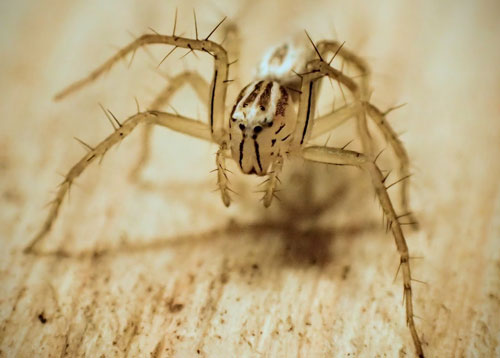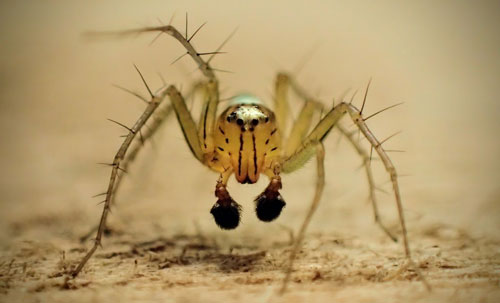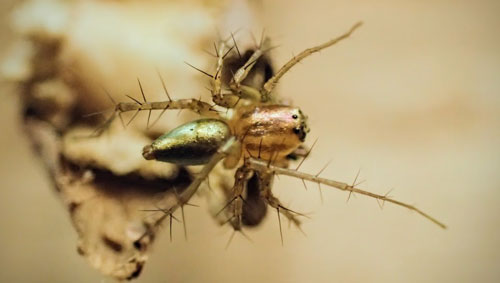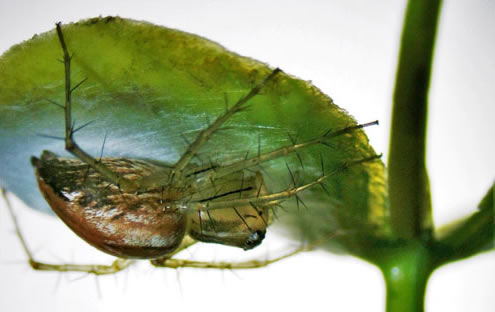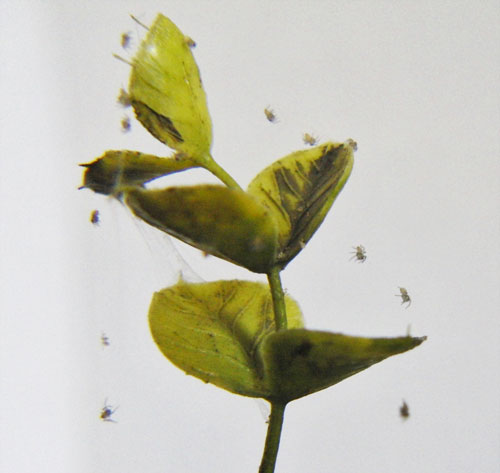common name: striped lynx spider
scientific name: Oxyopes salticus (Hentz, 1845) (Arachnida: Araneae: Oxyopidae)
Introduction - Synonymy and Nomenclature - Distribution - Description - Behavior - Economic Importance - Selected References
Introduction (Back to Top)
The striped lynx spider, Oxyopes salticus (Hentz), is a small, spiny-legged spider and generalist predator that feeds on a wide variety of insect prey, including several economically important insect pests. This lynx spider species is one of the most abundant beneficial spider species in gardens, yards, and agricultural fields throughout North America. Lynx spiders get their name from the catlike hunting behavior of ambushing or slowly stalking and pouncing on prey (Brady 1975). As a cursorial spider that does not make webs to capture prey, the striped lynx spider instead uses silk to protect its eggs and make silk supports for resting on vegetation. For the striped lynx spider, Oxyopes salticus, the name salticus stems from the Latin word saltus, meaning jumping. This is a fitting name because of its interesting behavior of waving its front pair of legs and jumping rapidly and frequently through vegetation (Brady 1964).
Figure 1. Adult female striped lynx spider, Oxyopes salticus (Hentz). Note the spiny legs and the black markings on the face that are characteristic of this species. Photograph by Laurel Lietzenmayer, University of Florida.
Figure 2. Dorsal view of an adult female striped lynx spider, Oxyopes salticus (Hentz). Photograph by Laurel Lietzenmayer, University of Florida.
Synonymy (Back to Top)
Oxyopes salticus Hentz, 1845
Oxyopes astutus Hentz, 1845
Sphasus luteus Blackwall, 1862
Oxyopes varians Taczanowski, 1874
Oxyopes gracilis Keyserling, 1877
Oxyopes m-fasciatus Piza, 1938
Oxyopes nigrolineatus Mello-Leitão, 1941
Distribution (Back to Top)
A total of 18 lynx spider species (family Oxyopidae) can be found in North America, including two species in the genus Oxyopes. The striped lynx spider is native to North America and is very common in the east and on the Pacific coast from Oregon south, but it is not found in the Rocky Mountains, the Great Basin, or the Midwest (Bradley 2012). It also occurs in Mesoamerica (Brady 1975), South America, and the West Indies (Santos 2017). The striped lynx spider is typically found in agricultural fields, tall grasses, prairies, backyards, gardens, and old fields (Young and Lockley 1985, Bradley 2012). The western lynx spider, Oxyopes scalaris (Hentz), occurs across the United States and Canada and is more common in the west compared to the striped lynx spider.
Description (Back to Top)
Lynx spiders (family Oxyopidae) are variable in size (4 to 16 mm) and can be characterized by relatively long chelicerae (fangs) in proportion to their head, many conspicuous spines on their legs, and a long abdomen that tapers towards the back end of the body (Bradley 2012). Lynx spiders have a distinct eye arrangement of six similarly sized eyes that create a hexagon at the top of the head region and another pair of smaller eyes under this hexagon on the front of the face (Bradley 2012).
Striped lynx spiders are relatively small (4 to 7 mm) and can be distinguished from other lynx spiders by two thin black lines extending from the small middle pair of eyes to the tips of the chelicerae and thin black lines on the undersides of their legs (Bradley 2012, Figure 1 and 3). Males and females have striking differences.
Females have a pale-yellow head with rows of white and dark bands lining the top of the body and are 5.7 to 6.7 mm in total body length (Comstock 1940, Bradley 2012, Figures 1 and 2). Males resemble females, but have a copper colored iridescent head, distinct club-shaped black pedipalps (small appendages below their face), and an abdomen covered in iridescent scales that can appear silvery green or purple (Comstock 1940, Bradley 2012, Figures 3 and 4). Males are smaller than females at 4.0 to 4.5 mm in total body length (Bradley 2012).
Other closely related lynx spiders are commonly found throughout North America, such as the green lynx spider, Peucetia viridans (Hentz). The green lynx spider can be distinguished from the striped lynx spider by its larger size (12 to 16 mm), green body, and lack of the distinctive black markings on the face. The striped lynx spider’s closest relative in North America, the western lynx spider, is more brown in color, has banded legs, and lacks the black stripes on the face and iridescent body that are characteristic of the striped lynx spider (Bradley 2012).
Figure 3. Frontal view of an adult male striped lynx spider, Oxyopes salticus (Hentz). Note the male’s conspicuous dark pedipalps (appendages below the face), as well as the characteristic black facial markings. Photograph by Laurel Lietzenmayer, University of Florida.
Figure 4. Dorsal view of an adult male striped lynx spider, Oxyopes salticus (Hentz). Note the characteristic iridescent dorsal coloration. Photograph by Laurel Lietzenmayer, University of Florida.
Behavior (Back to Top)
To capture prey, the striped lynx spider will sit and wait in grassy areas and herbaceous vegetation for small insects to land close enough for them to stalk and capture (Brady 1975). This spider can detect odors given off by insect prey and will spend time in areas within the vegetation where those odors are strongest (Punzo and Kukoyi 1997). There is evidence that spiderlings can learn specific odors during foraging and retain specific prey preferences from these experiences later in life (Punzo 2002a, Punzo 2002b). Research shows that newly hatched spiderlings can feed on nectar, which can help them live longer and reduce cannibalism from non-related lynx spiderlings (Lietzenmayer and Wagner 2017). Other sources of sugars, including honeydew, may be potentially important to immature spiders (Benhadi-Marín et al. 2019).
Female striped lynx spiders mate only once, but males use a distinct courtship display to mate with multiple females (Young and Lockley 1985). About 7 to 33 days after mating, a female will produce a small, flat egg sac on the underside of a leaf; the egg sac is 10 to 15 mm in diameter and is covered by white silk (Young and Lockley 1985, Figure 5). Females will tend to egg sacs until spiderlings begin to emerge after about 20 days (Lietzenmayer and Wagner 2017). When spiderlings emerge from an egg sac, they remain in silk scaffolding on a plant for one to five days until they begin to disperse by releasing a thread of silk into the air and letting the wind carry them to a new location (commonly referred to as ballooning) (Whitcomb and Eason 1967, Figure 6). It takes about nine months for striped lynx spiders to mature from egg hatch to adult, with a total lifespan of only one year (Whitcomb and Eason 1967). The breeding season occurs from spring to late summer in most parts of their range (Whitcomb and Eason 1967).
Figure 5. Adult female striped lynx spider, Oxyopes salticus (Hentz), resting on top of an egg sac on the underside of a leaf. Photograph by Laurel Lietzenmayer, University of Florida.
Figure 6. Newly hatched striped lynx spiderlings, Oxyopes salticus (Hentz), on silk scaffolding covering a plant. Photograph by Laurel Lietzenmayer, University of Florida.
Economic Importance (Back to Top)
The striped lynx spider is one of the most abundant and beneficial spider species found in agricultural ecosystems; it is particularly common in cotton, soybean, grain sorghum, and alfalfa and feeds on a wide range of pest species (Young and Lockley 1985, Nyffeler et al. 1987, Nyffeler et al. 1992). Surveys in cotton showed that the striped lynx spider feeds on insects predominately in the orders Hemiptera, Hymenoptera, and Diptera, and even on other spiders (Nyffeler et al. 1987, Nyffeler et al. 1992). The striped lynx spider is considered a major predator of bollworm (Helicoverpa zea) and tobacco budworm (Heliothis virescens) larvae in cotton fields and the southern green stink bug (Nezara viridula) in soybean fields (Whitcomb 1967, Stare 1978, McDaniel et al. 1981).
The striped lynx spider is significantly affected by insecticide use that causes decreased survival and other sublethal effects, such as causing males to decrease the amount of time they spend courting and mating with females (Hanna 2013, Hanna 2014). It may be possible to use the striped lynx spider as a vector of a nuclear polyhedrosis virus to control the soybean pest Anticarsia gemmatalis (Hübner) (Kring et al. 1998). When striped lynx spiders consume Anticarsia gemmatalis larva that are infected with the virus, they excrete 95% of the active virus back onto vegetation to be eaten by more larva (Kring et al. 1998).
Selected References (Back to Top)
- Benhadi-Marin J, Pereira JA, Sousa JP, Santos SAP. 2019. Spiders actively choose and feed on nutritious non-prey food resources. Biological Control 129: 187-194. https://doi.org/10.1016/j.biocontrol.2018.10.017
- Blackwall J. 1862. Descriptions of newly discovered spiders captured in Rio de Janeiro, by John Gray and the Rev. Hamlet Clark [part]. Annals and Magazine of Natural History 10: 348-360. https://doi.org/10.1080/00222936208681337
- Brady AR. 1964. The lynx spiders of North America, north of Mexico (Araneae: Oxyopidae). Bulletin of the Museum of Comparative Zoology 131: 429-518.
- Brady AR. 1975. The lynx spider genus Oxyopes in Mexico and Central America (Araneae: Oxyopidae). Psyche 82: 189-243.
- Bradley RA. 2012. Common Spiders of North America. University of California Press, Berkeley, CA. 271 pp.
- Comstock JH. 1948. The Spider Book. Doubleday, Doran and Company, New York City, NY. 729 pp.
- Hanna C. 2013. The lethal and sublethal effects of three pesticides on the striped lynx spider (Oxyopes salticus Hentz). Journal of Applied Entomology 137: 68-76. https://doi.org/10.1111/jen.12014
- Hanna C. 2014. Sublethal pesticide exposure disrupts courtship in the striped lynx spider, Oxyopes salticus (Araneae: Oxyopidae). Journal of Applied Entomology 138: 141-148. https://doi.org/10.1111/jen.12081
- Hentz NM. 1845. Descriptions and figures of the araneides of the United States. Boston Journal of Natural History 5: 189-202.
- Keyserling E. 1877. Ueber amerikanische Spinnenarten der Unterordnung Citigradae. Verhandlungen der Kaiserlich-Königlichen Zoologisch-Botanischen Gesellschaft in Wien 26: 609-708.
- Kring TJ, Young SY, Yearian WC. 1988. The striped lynx spider, Oxyopes salticus Hentz (Araneae: Oxyopidae), as a vector of a nuclear polyhedrosis virus in Anticarsia gemmatalis Hübner (Lepidoptera: Noctuidae). Journal of Entomological Science 23: 394-398. https://doi.org/10.18474/0749-8004-23.4.394
- Lietzenmayer LB, Wagner JD. 2017. Effects of nectar feeding on cannibalism in striped lynx spiderlings Oxyopes salticus (Araneae: Oxyopidae). Journal of Arachnology 45: 356-360. https://doi.org/10.1636/JoA-S-16-079.1
- McDaniel SG, Sterling WL, Dean DA. 1981. Predators of tobacco budworm Iarvae in Texas cotton. Southwestern Entomologist 6: 102-108.
- Mello-Leitão CF de. 1941. Las arañas de Córdoba, La Rioja, Catamarca, Tucumán, Salta y Jujuy colectadas por los Profesores Birabén. Revista del Museo de La Plata (N.S., Zool.) 2: 99-198.
- Nyffeler M, Dean DA, Sterling WL. 1987. Evaluation of the importance of the striped lynx spider, Oxyopes salticus (Araneae: Oxyopidae), as a predator in Texas cotton. Environmental Entomology 16: 1114-1123. https://doi.org/10.1093/ee/16.5.1114
- Nyffeler M, Dean DA, Sterling WL. 1992. Diets, feeding specialization, and predatory role of two lynx spiders, Oxyopes salticus and Peucetia viridans (Araneae: Oxyopidae), in a Texas cotton agroecosystem. Environmental Entomology 21: 1457-1465. https://doi.org/10.1093/ee/21.6.1457
- Piza Jr S de T. 1938. Duas novas aranhas oxyópidas do Brasil. Boletim Biológico Sao Paulo (N.S.) 3: 47-48.
- Punzo F. 2002a. Early experience and prey preference in the lynx spider, Oxyopes salticus Hentz (Araneae: Oxyopidae). Journal of the New York Entomological Society 110: 255-259. https://doi.org/10.1664/0028-7199(2002)110[0255:EEAPPI]2.0.CO;2
- Punzo F. 2002b. Food imprinting and subsequent prey preference in the lynx spider, Oxyopes salticus (Araneae: Oxyopidae). Behavioural Processes 58: 177-181. https://doi.org/10.1016/S0376-6357(02)00031-1
- Punzo F, Kukoyi O. 1997. The effects of prey chemical cues on patch residence time in the wolf spider Trochosa parthenus (Chamberlin) (Lycosidae) and the lynx spider Oxyopes salticus Hentz (Oxyopidae). Bulletin of the British Arachnological Society 10: 323-326.
- Santos AJ. 2017. The jumping lynx spider Oxyopes salticus Hentz, 1845 and its Neotropical relatives (Araneae: Oxyopidae). Zootaxa 4216: 457-481. https://doi.org/10.11646/zootaxa.4216.5.3
- Stare PA. 1978. Relation of predators to population dynamics of Nezara viridula (L.) in a soybean ecosystem. Ph.D. Thesis, Louisiana State University, Baton Rouge: 237 pp.
- Taczanowski L. 1874. Les aranéides de la Guyane française. Horae Societatis Entomologicae Rossicae 10: 56-115.
- Whitcomb WH.1967. Field studies of predators of the second-instar bollworm, Heliothis zea (Boddie) [Lepidoptera: Noctuidae]. Journal of the Georgia Entomology Society 2: 113-118.
- Whitcomb WH, Eason RR. 1967. Life history and predatory importance of the striped lynx spider (Araneida: Oxyopidae). Journal of the Arkansas Academy of Science 21: 54-58.
- Young OP, Lockley TC. 1985. The striped lynx spider, Oxyopes salticus [Araneae: Oxyopidae], in agroecosystems. Entomophaga 30: 329-346. https://doi.org/10.1007/BF02372339
